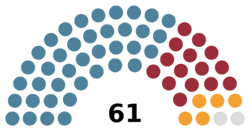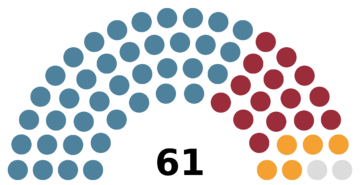Mava Council
Mava Council Maava Taapiit | |
|---|---|
 | |
| Type | |
| Type | |
| Leadership | |
Administrator of Mava | Asamak Umaakasarmuk since 19 August 2021 |
Chairman | Taarjut Niunak since 22 May 2023 |
Leader | Kausaanek Malaati since 22 March 2023 |
| Structure | |
| Seats | 10 |
 | |
Political groups | Nonpartisan: 10 seats
|
| Elections | |
| Block voting | |
Last election | 11 May 2023 |
Next election | before 8 May 2025 |
| Meeting place | |
| Maavaakitat, Paas, Mava | |
| Website | |
 |
|---|
| This article is part of a series on the politics and government of Mava |
|
The Assembly of the Islands (Mavean: Tokukuaawnuktaagik) is the unicameral legislature of the Republic of Mava, serving as the confederal legislative branch responsible for passing laws applied across all jurisdictions.
The Assembly was established in the 1925 Constitution, replacing the colonial-era Legislative Council that had been founded in 1908 to advise the governor. Ahead of independence, the leaders of Mava's four distinct peoples signed the Paas Agreement, which recognised the sovereignty of these groups and affirmed the creation of a confederal system on independence. The Assembly of the Islands was created as the supreme legislative branch of the confederation, with carefully defined power to make laws that are binding on all jurisdictions. It also elects the Government Council, which constitutes the executive branch of the confederation.
Members are elected for two years via bloc voting. Members represent multi-member constituencies and are required to represent these constituencies rather than their home jurisdiction.
History
The Parliament of Mava was created on 1 April 1925 through the Mavean Independence Act, passed by the Atitlanese Congress. The members were carried over from the membership of the Legislative Council, which had served as the appointed advisory body to the colonial governor. Under the interim provisions, Mava was governed by a Transitional Government of the Parliament, appointed by Parliament to govern until elections could be held. The first elections were held on 14 May 1925, with Kuraava Tanigak appointed president by Parliament. The body was made permanent following the passage of the first Mavean constitution in September 1925, with the division of its powers between the newly established Nominated Assembly and Legislative Assembly.
The 1943 constitution radically increased the powers of parliament, transforming Mava from a presidential to a parliamentary republic. The prime minister, a member of the Legislative Assembly, formally became head of government and answerable to the Legislative Assembly rather than the president. The Legislative Assembly also assumed powers to dismiss governments with the abolition of the assembly-independent system, and its members became the sole initiators of legislation, with the president previously able to propose bills. The Nominated Assembly had its power of veto removed, now only able to recommend amendments and supervise the drafting of laws. It remains responsible for ensuring the legality of any laws passed in the lower house.
Under the 1943 constitution, the president of the parliament appointed a "Grand Committee of the National Parliament", composed of members of both houses appointed for the purpose of electing the president and approving the nominations of judges and other officials. The body was abolished in 1994; an Electoral College was created to elect the president, whilst responsibility for approving nominations was transferred to the House of Representatives.
Powers and procedure
The Assembly is the legislative arm of the confederal government and is one of the "Organs of the Confederation." The body has authority to legislative in a specified field of competences known as "transferred responsibilities." These responsibilities are those areas of policymaking that the jurisdictional parliaments have voluntarily agreed to transfer to confederal competence, with any laws made in the Assembly applying without qualification across the whole confederation. Responsibilities under the authority of the confederal assembly include national security, trade and customs, foreign policy, and fiscal and monetary policy. There are also matters which the Assembly may legislate on in consultation with and with the consent of the jurisdictions, including healthcare, transport, and education. In reality, these "consultative competences" are far more centralised.
The Assembly also has responsibility for electing the Government Council - the executive arm of the confederal government. The Chairman of the Government Council (the prime minister) is elected by the Assembly, usually as the leader of the largest party. The Assembly then elects seven other members to serve in the council, with the requirement that there be two members from each jurisdiction. It is the responsibility of the Assembly to then approve the allocation of ministerial responsibilities to these members.
The President of the Assembly is the presiding officer and is elected at the same time as other confederal officers. The president is responsible for ensuring good conduct amongst members, directing the proceedings of the house, and maintaining order. They are assisted by a vice president. The President and Vice President are usually drawn from the largest and second-largest parties respectively, although this is only a convention.
To ensure that the wishes of all jurisdictions are respected, members are divided into "jurisdictional delegations." All matters put before the assembly require a majority of members of each delegation rather than a simple overall majority. For an ordinary law (A1) to be approved, a majority of each delegation is required; a constitutional amendment (A2) requires two-thirds of each delegation.
| Jurisdiction | Number of votes | Minimum votes required | |
|---|---|---|---|
| A1 | A2 | ||
| North Mava | 27 | 14 | 18 |
| South Mava | 20 | 10 | 14 |
| Tokuksiagak | 11 | 6 | 8 |
| Taak | 7 | 4 | 5 |
Committees
The Assembly has a number of joint committees that draw membership from both houses. There are currently 11 committees, the majority of which correspond with government departments:
- Committee on Finance and the Economy
- Committee on Foreign Affairs
- Committee on Public Security
- Committee on Public Health, Sport, and Fitness
- Committee on Education, Culture, and Youth
- Committee on the Environment
- Committee on Justice
- Committee on Administration
- Committee on Media and Youth
- Committee on Equality and Integration
- Committee on Fisheries and Employment
Elections
General elections occur whenever the assembly is dissolved. Dissolutions occur automatically two years from the date of the first meeting, although it is common for dissolutions to occur in March, at least six weeks prior to the date of the next election. Elections are usually held in the second week of May (generally a Thursday), following an electoral campaign of no less than 35 days. Candidates are generally nominated by political parties, although a small number of independent candidates have won seats.
Candidates are required to file a nomination paper bearing the signatures of at least 50 constituents. Each constituency returns two or more members of Parliament using the block voting electoral system, in which voters may cast as many votes as there are available seats, with a simple plurality required. To stand as and vote for a candidate, one must be a Mavean citizen and at least eighteenth years of age. Additional eligibility requirements are imposed on electoral candidates.
Members serve a two year term. Should a member die, resign, or otherwise cease to hold their seat, a by-election is held in the relevant constituency under the same rules and procedures as in general elections. Individuals expelled by the Assembly are not permitted to run in the following by-election, although they may be a candidate in the next general election (even if no subsequent by-election is held).
Constituencies
61 members are returned from multi-member constituencies. Each district is divided into a number of constituencies based on their population, each returning an allocated number of members. The distribution of constituencies is reviewed every ten years by the Mavean Elections Office, with a requirement that each seat represents between 750 and 1,250 people.
| District | Seats | MPs |
|---|---|---|
| Aasqaalet | 3 | 11 |
| Miilep | 2 | 5 |
| Paas | 8 | 21 |
| Pmaak | 4 | 9 |
| Kungaatiibisa | 1 | 2 |
| Taagokiajut | 1 | 3 |
| Sigaak | 2 | 5 |
| Saayup | 1 | 3 |
| Taak | 1 | 2 |
The current set of constituency boundaries came into effect ahead of the May 2015 parliamentary elections. Prior to this, Paas had 25 seats, which were re-allocated to Aasqaalet and Pmaak.
2023 election
See also
- Politics of Mava
- Culture of Mava
Notes
External links
- National Parliament of Mava. aawnuhiuakak.mv
